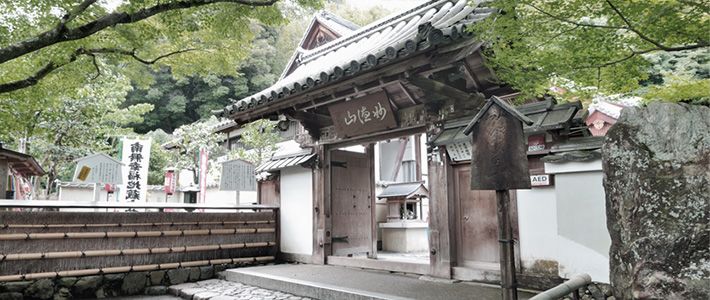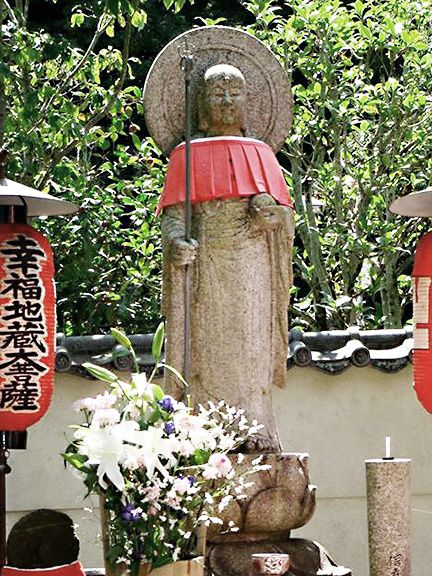
Sneakers for a God
Society Lifestyle- English
- 日本語
- 简体字
- 繁體字
- Français
- Español
- العربية
- Русский
The temple of Kegonji in the Arashiyama district of western Kyoto is popularly known as Suzumushidera on account of the many bell crickets (suzumushi) found there. I am extremely fond of this temple, which has been a thriving place of worship for centuries. In winter, with a fresh layer of snow covering the roofs and trees, the temple grounds have an inexpressible beauty.
The Song of the Bell Crickets
Suzumushidera is a very popular temple, as the endless lines of visitors attest. But it is primarily a place of worship rather than a tourist attraction, so before exploring the grounds, one must attend a sermon. As one files into the lecture hall with its tatami-covered floor, one is greeted by the cool, refreshing chirp of bell crickets, which are kept in a plexiglass box on the desk. The packed room is stuffy, however, with heaters going at full blast, as the crickets need to be warm in order to sing.
Usually, bell crickets are heard only in autumn, but at Suzumushidera they can be heard all year round. In Japan, where seasonal phenomena from cherry blossoms to monsoon rains and typhoons occur with almost clockwork regularity, there are few places where one can hear the singing of insects throughout the year. This is one reason so many Japanese visitors flock to Suzumushidera.
The beautiful song of the aptly named bell cricket makes numerous appearances in traditional Japanese poetry. In Murasaki Shikibu’s classic work Genji monogatari (The Tale of Genji), one of the heroines composes this poem:
The autumn is a time of deprivation,
I have thought—and yet have loved this cricket.(*1)
Less Than Omnipotent
 With this ringing accompaniment, the sermon begins. The middle-aged priest tells the audience not only about the crickets but also about the history and lore of the temple. Speaking of the statue of the Buddhist divinity Jizō, which draws many visitors, he tells us that the bodhisattva always heeds the prayers of supplicants. You need only approach the statue quietly and say what you desire, he says. Some may wish for a happy marriage, others for admission to university; each soul has its own longing.
With this ringing accompaniment, the sermon begins. The middle-aged priest tells the audience not only about the crickets but also about the history and lore of the temple. Speaking of the statue of the Buddhist divinity Jizō, which draws many visitors, he tells us that the bodhisattva always heeds the prayers of supplicants. You need only approach the statue quietly and say what you desire, he says. Some may wish for a happy marriage, others for admission to university; each soul has its own longing.
The priest does not promise an immediate miracle, but he assures us that as long as one’s faith in the kindness of Jizō is strong, eventually one’s prayer will be fulfilled. That is why it is essential to inform the temple of your new address if you should happen to move in the meantime. Any method of communication is fine: letter, fax, telephone, email . . .
The Japanese people around me take this all in stride, but I find the last part startling. It seems strange to me that you would need to notify Jizō of your new address, as if he were a postman. I am accustomed to the Christian idea of an omniscient, omnipotent God. Christians are taught that God sees all. He knows instantly if you sin, even if no one else finds out. The same applies to good deeds. Nothing can be hidden from God.
The Walking God
The gods of the Japanese have a different character. Japanese Buddhism is heavily influenced by the indigenous religion of Shintō, with its vast pantheon of deities. For the most part, the Shintō kami are local deities whose power is limited, and this concept of divinity has permeated Japanese Buddhism as well. Japanese gods are more accessible, closer to the human level, than the gods of monotheistic religions. Of course, they are more powerful than people, but they do not have the absolute, divine majesty of the Christian God. More emphasis is placed on compassion and other human qualities.
Unlike the typical image of Jizō, which depicts a barefoot monk, the Jizō of Suzumushidera is portrayed wearing straw sandals. Some worshippers bring him sandals as offerings, imagining that the deity goes through his footwear quickly as he trudges about fulfilling the prayers of so many supplicants. Straw sandals are customary, but recently I have spotted comfortable sneakers and walking shoes on the racks set up for offerings. Surely Jizō will don them gratefully and make good use of them on his walks.
(Originally written in Russian on April 11, 2014.)
(*1) ^ Murasaki Shikibu, The Tale of Genji, trans. Edward G. Seidensticker (New York: Knopf, 1976).